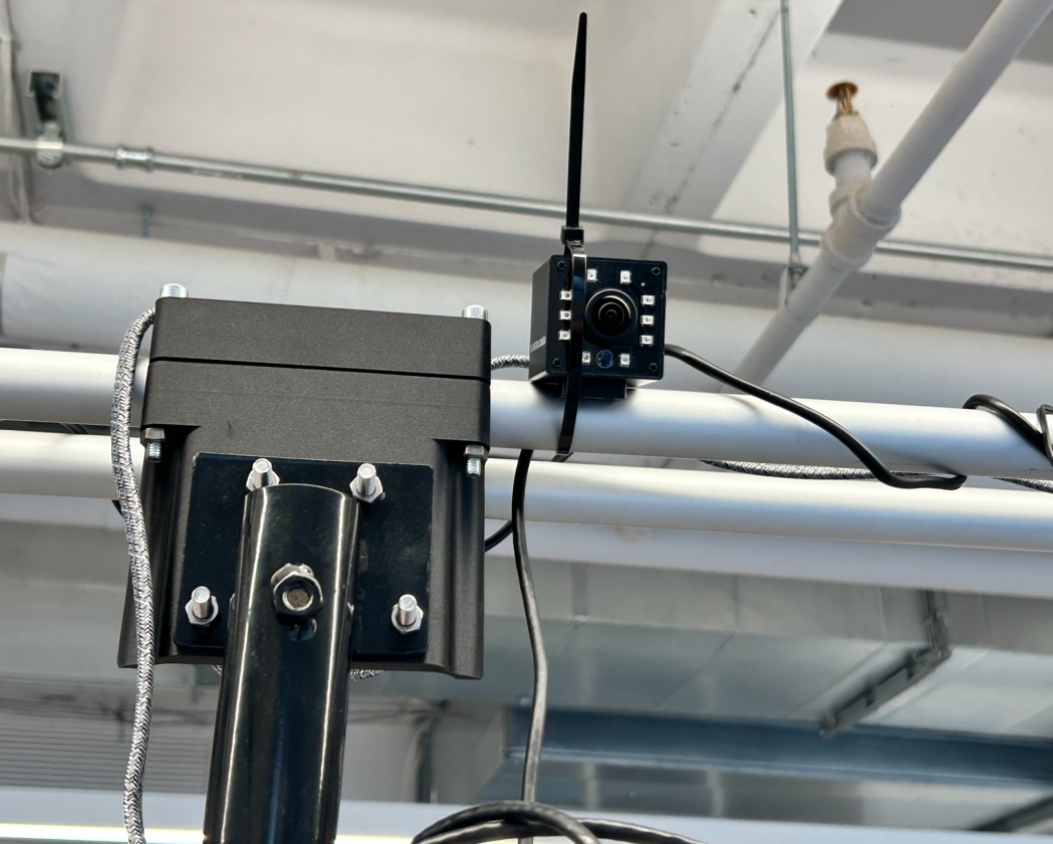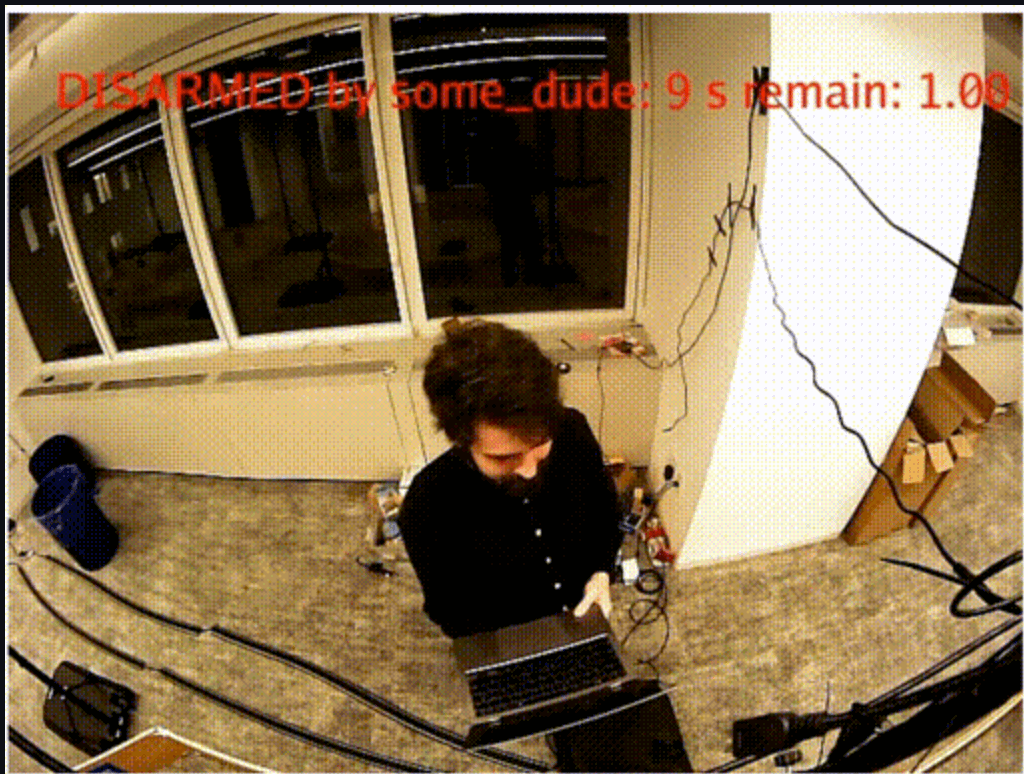A security system based on face identification
Security systems often include a human component, like a supervisor who monitors camera streams for suspicious activity. In this tutorial, you will learn how to build a security system that detects people and intelligently decides whether to raise an alarm. The system decides whether to raise an alarm based on whether it recognizes the face of the detected person using a machine learning model.
Architecture
- The system uses a camera to obtain a live video stream.
- To detect people on the video stream, the system uses a people detection model, which can identify whether an object detected in your video stream is a person or not.
- You will need to obtain images of all the people whom the security system should know about. The face identification model uses the DeepFace library in conjunction with these photos to recognize people.
- The
verification-systemmodule provides a vision service that applies the two models to the camera stream. It also implements logic that starts a countdown when it detects a person in the camera stream and then decides whether to trigger an alarm based on whether it recognizes the person’s face or not.

Prerequisites
Configure the camera
Navigate to the CONFIGURE tab of your machine’s page.
Configure the camera you want to use for your security system.
Click the + icon next to your machine part in the left-hand menu and select Component or service.
Select the camera type, then select the webcam model or another model if you are using a different camera.
Enter the name my_webcam for your camera and click Create.
Position your camera somewhere where it can detect people.

Test the camera stream.
Click on the camera’s TEST panel to see the camera stream.
Configure the people detector
In order for your machine’s camera to detect the presence of a person in its field of vision, we recommend using the EfficientDet-COCO model from the Viam Registry.
The model can detect a variety of objects, which you can see in the person label.
Want to train your own model instead?
If you wish to train your own ML model, see Train a TF or TFLite model.
To run the machine learning model on your machine, use the ML model service:
- On your machine’s CONFIGURE tab, click the + icon next to your machine part in the left-hand menu and select Component or service.
- Select type
ML model, then select modelTFLite CPU. - Enter
persondetectas the name for your ML model service, then click Create. - On the ML model service panel, select Deploy model on machine for the Deployment field.
- Click Select model, then select the EfficientDet-COCO model by viam-labs from the Registry tab of the modal that appears.
- Add the
vision / ML modelvision service to your machine and name itperson-detector. - On the vision service panel, select
persondetectas the ML Model andmy_webcamas the Default Camera.
Now you are ready to configure the face identification model.
Configure face identification
You now have a machine capable of detecting people in its camera feed. To make it an intelligent security system, it also needs to identify specific people in order to decide whether to trigger an alarm.
To do this, you can use the face-identification module, which uses Facebook’s DeepFace library to perform face identification:
Add images of people that the system should recognize.
Get a few pictures of each person that the system should be able to identify. The pictures should clearly show the face of the person in good lighting, with all facial features visible.
In the finished system, any person who walks in front of your machine’s camera and is not identified will trigger an alarm!
Copy the images to your machine’s filesystem and place them into a folder structure like this:
path/
└── to/
└── known_faces/
└── john_doe/
| ├── john_1.jpeg
| └── john_2.jpeg
└── jane_doe/
| ├── jane_1.png
| └── jane_2.jpeg
└── admin_team/
└── group_photo.png
For example, you can use the scp command to transfer an image to your machine like so:
scp -r /path/to/known_faces username@my-machine.local:/home/known_faces
You need the path to the
Add the face identification vision service.
On your machine’s CONFIGURE tab, add the vision / face-identification vision service and name it face-detect.
On the panel that appears, enter the following configuration in the attributes field, making sure to update the picture_directory path to point to your
{
"camera_name": "my_webcam",
"picture_directory": "/path/to/known_faces"
}
For more configuration options, see the viam-face-identification module documentation.
Test the face identification.
Click on the face-detect vision service’s TEST panel.
Whenever a known face is detected, you should see a bounding box with the person’s name around the face.
Configure the security system
Now that you have configured both the people detector and the face identification service, you are ready to add the alarm logic that combines both.
The verification-system module contains the required logic.
It uses the camera stream, the people detector, and the face identification service to decide when to raise an alarm.
On your machine’s CONFIGURE tab, add the
vision / verification-systemvision service and name itverification-system.On the panel that appears, enter the following configuration into the attributes field:
{ "camera_name": "my_webcam", "trigger_1_detector": "person-detector", "trigger_1_labels": ["Person"], "trigger_1_confidence": 0.35, "trigger_2_detector": "person-detector", "trigger_2_labels": ["Person"], "trigger_2_confidence": 0.5, "verification_detector": "face-detect", "verification_labels": ["john_doe", "jane_doe"], "disable_alarm": false, "disarmed_time_s": 10, "countdown_time_s": 10 }The
verification-systemmodule uses distinct states. Its default state is calledTRIGGER_1, which the system is in when there are low-confidence detections or no detections.If a person is detected in the camera stream with high confidence, the system will go into the
COUNTDOWNstate. During the countdown, it waits for a verified face to be identified by the configuredverification_detector, which is theface-detectvision service. If the face identification service returns a label that is in theverification_labelsarray within the 10-second countdown, no alarm will be raised. Otherwise the system raises an alarm.For a more detailed overview on the states, see the
verification-systemmodule documentation.If you used different names for your camera, model, or vision service, update them.
Also update the
verification_labelsto use the names of the people your system can detect - these are the folder names inside theknown_faces folder.For more configuration information, see the
verification-systemmodule documentation.
Test the system
At this point, your machine is fully capable of detecting people in its camera feed and identifying whether a specific detected person is “approved” (as specified under "verification_labels") or not.
To see this in action, click on the verification-system’s TEST panel to see the camera stream.
The current state of the verification-system is visible as an overlay on the camera stream.
It should be TRIGGER_1 if no people are visible.
Have one or more people walk in front of the camera and look directly at it.
Watch the state change to COUNTDOWN and then DISARMED when an approved person is detected, or to ALARM if no approved person appears within 10 seconds.

Using the alarm state
The alarm state currently does not cause anything to happen besides appearing as an overlay on the camera stream.
To trigger an audio alarm or have your machine take an action based on the reported state, you can fork the verification-system module to add logic when the system enters the ALARM state.
Next steps
Now that you have the verification aspect of your system working, you can use this as a launch point for customizing your own DIY home security system.
To dive deeper, we recommend looking at the verification-system module logic.
Was this page helpful?
Glad to hear it! If you have any other feedback please let us know:
We're sorry about that. To help us improve, please tell us what we can do better:
Thank you!